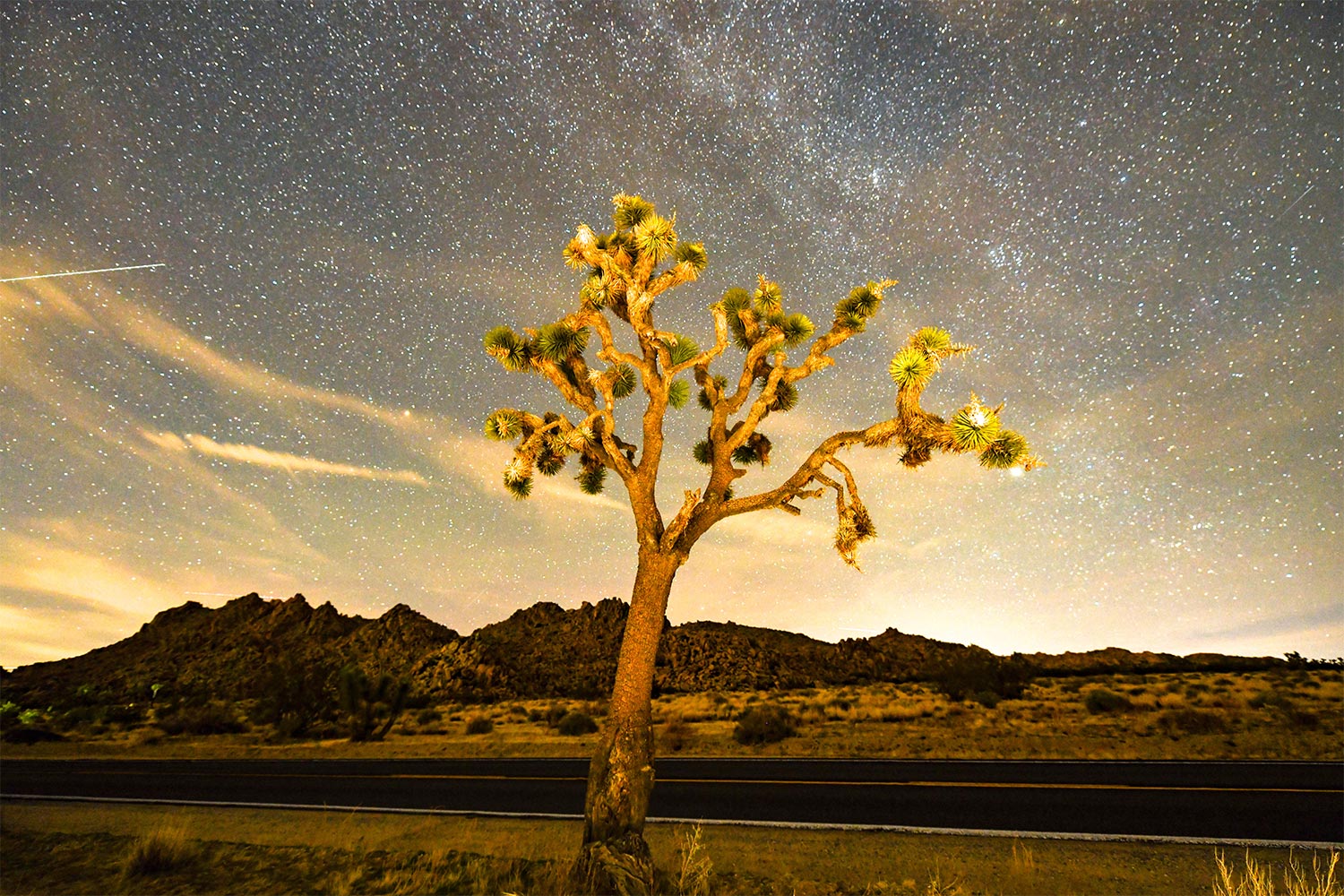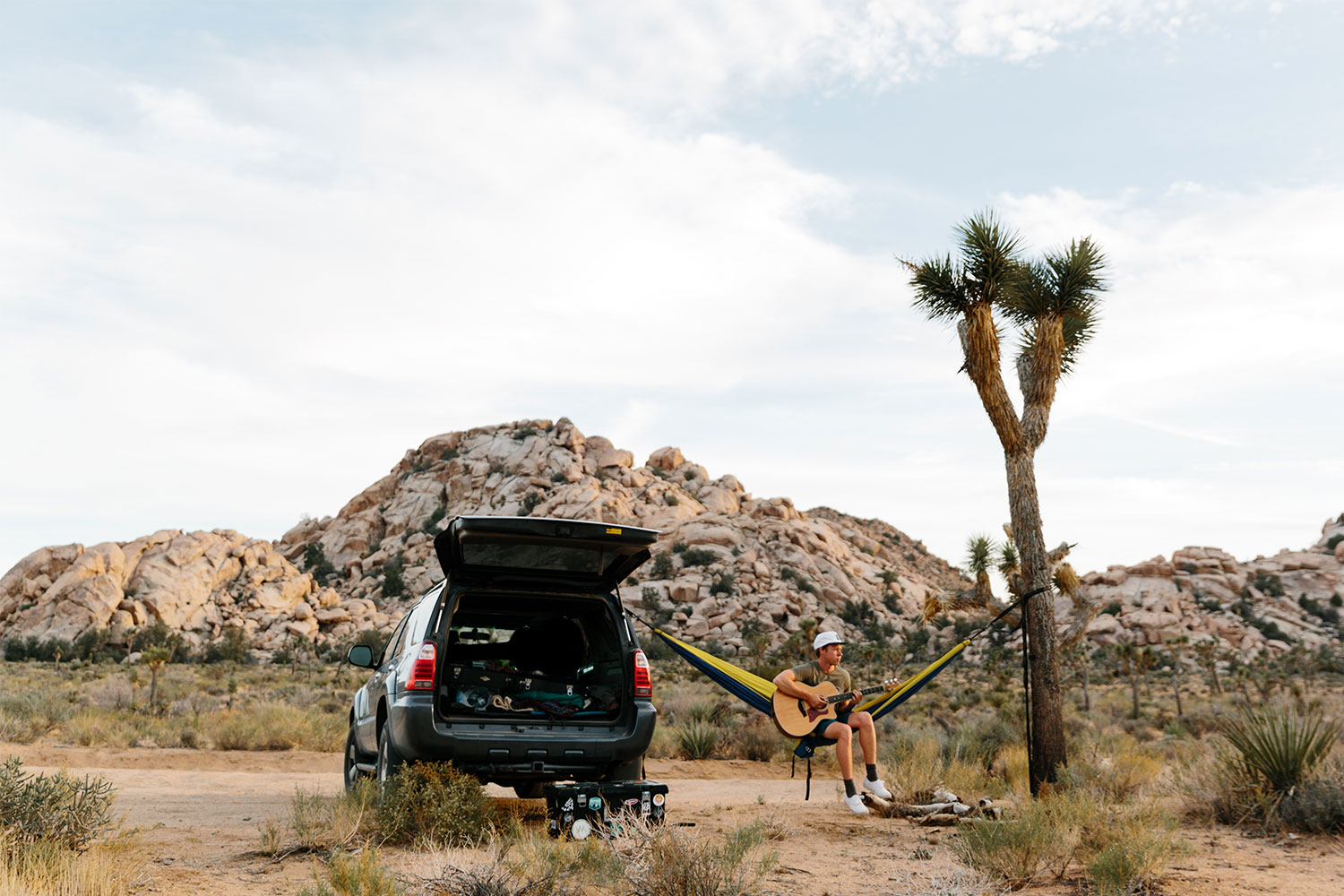Table of contents
In my opinion, exploring Joshua Tree National Park is a totally captivating journey that goes far beyond the eponymous trees you may have already seen on social networks. It’s one of the most beautiful parks I’ve visited in the USA, and here’s why…
This seemingly barren desert reveals, on closer inspection, a complex and striking ecosystem. From life-filled oases to the remnants of man’s attempts to tame this wilderness, from plains covered in bushy cacti to exposed gnarled rock formations, this park is a diverse and complex natural wonder.
The Joshua Tree, which gives the park its name, was named by early Mormon settlers who saw in its upright limbs and bearded appearance a resemblance to the biblical prophet Joshua. However, it’s not really a tree, but a variety of yucca, part of the agave family.
The park spans two distinct desert environments: the Joshua-tree-studded Mojave Desert to the northwest, and the warmer, drier Colorado Desert to the south and east, characterized by a wide variety of desert flora, including cacti, ocotillo and California palms. The “transition zone” that separates them has characteristics of both.

A little history…
The geological history of this region spans almost 2 billion years. Eight million years ago, it was a landscape of rolling hills and flourishing grasslands, home to a variety of wildlife. The Oasis Visitor Center shows how climatic, volcanic and tectonic forces sculpted the park’s distinctive cliffs and boulders, transforming Joshua Tree into the arid desert we see today. Traces of human occupation date back almost 10,000 years – can you believe it? Native American rock art is scattered throughout the park.
Miners and ranchers arrived in the 1860s, but the boom faded in the early 20th century. Dr. James Luckie prescribed the clean, dry desert air as a remedy for World War I veterans, sparking modern interest in the area.
In the 1920s, a worldwide fascination with the desert emerged, leading to the creation of cactus gardens. Entrepreneurs transported truckloads of desert plants to Los Angeles for sale or export, and souvenir hunters extracted archaeological treasures. Concerned about the impoverishment of the magnificent Mojave, Pasadena socialite Minerva Hoyt championed the desert conservation movement, which eventually led to the creation of Joshua Tree National Monument in 1936.
What to do in Joshua Tree ?
In 1994, Joshua Tree was granted national park status in the USA and expanded to nearly 800,000 acres under the federal California Desert Protection Act. Here are a few things to do when you visit this remarkable national park:
- Hike through the diverse desert landscapes, exploring trails that take you past unique rock formations and through Joshua tree forests.
- Stargaze at one of the country’s best dark sky sites, where the Milky Way shines brightly.
- Discover a rich cultural history by visiting the Oasis Visitor Center and exploring Native American rock art.
- Climb the iconic granite formations that attract climbers from all over the world.
- Discover the surreal landscapes of Skull Rock, Arch Rock and Keys View.
- Birdwatch, as Joshua Tree is home to a wide variety of desert bird species.
- Visit the Cholla Cactus Garden to admire the enchanting spectacle of thousands of spindly cacti.
- Discover the desert’s unique flora and fauna through ranger-led programs and interpretive exhibits.
- Take a scenic drive through the park to immortalize its breathtaking vistas on your camera.
- Camping opportunities abound, so consider spending the night under the starry desert sky for a truly immersive Joshua Tree National Park experience.
Where Joshua Tree is located ?
Joshua Tree National Park is located in the US state of California. It is located primarily in San Bernardino County, but a small part of the park also extends into Riverside County. The park is about 130 miles (about 209 kilometers) east of Los Angeles and about 30 miles (about 48 kilometers) south of the city of Joshua Tree, California.
How to get to Joshua Tree ?
From Las Vegas
- Take Interstate 15 (I-15) south to Primm, Nevada.
- In Primm, cross the California state line and continue on I-15 south.
- Take exit 191 to merge onto Interstate 40 (I-40) west toward Barstow.
- Stay on I-40 west for approximately 45 miles.
- Take exit 25 to merge onto California State Route 95 (CA-95) south toward Needles.
- Continue on CA-95 south for approximately 60 miles.
- You’ll arrive at the northern entrance to Joshua Tree National Park.
From Los Angeles
- From Los Angeles, take Interstate 10 (I-10) east towards San Bernardino.
- Continue on I-10 east until you reach the town of Redlands.
- In Redlands, take exit 77 to join California State Route 62 (CA-62) east towards Yucca Valley and Joshua Tree.
- Follow CA-62 east for approximately 30 miles to the western entrance of Joshua Tree National Park.
From Palm Springs
- From Palm Springs, take California State Route 62 (CA-62) west towards Yucca Valley and Joshua Tree.
- Follow CA-62 west for about 25 miles.
- You’ll arrive at the western entrance to Joshua Tree National Park.
Make sure you have a map or GPS to help you find your way, as some parts of the region are quite remote, and it’s important to have enough water and fuel, as distances between gas stations can be considerable. Before setting off, it’s advisable to check road and weather conditions, especially during the summer months, as the region can be very hot.
What about prices?
Entrance fees to Joshua Tree National Park can vary depending on the time of year and how you plan to visit the park. Here’s some general information on entry fees to Joshua Tree National Park:
Entrance fees by private vehicle
The standard fee varies according to the season. Typically, it costs between $25 and $30 per vehicle for 7 days. This rate applies to a private vehicle and its passengers.
Pedestrian and bicycle entry fees
If you enter the park on foot or by bicycle, the fee is generally lower, at around 15 to 20 dollars per person, for a 7-day stay.
Motorcycle entry fees
If you enter the park by motorcycle, the fee is usually around $20 to $25 per motorcycle for 7 days.
Annual pass
For frequent visitors to the national parks, purchasing an annual inter-agency pass (America the Beautiful National Parks and Federal Recreational Lands Pass) is an economical option. This pass covers admission to numerous national parks, national forests, national monuments and more. The cost of such a pass is around $80 per year.
Where to stay in Joshua Tree?
Joshua Tree National Park offers several options for accommodation, whether in the park itself or in nearby towns. Here are some suggestions for places to stay in Joshua Tree, with general information and a few addresses:
Camping in the park
Joshua Tree National Park has several campsites run by the National Park Service. These campsites offer sites for tents and motorhomes, but operate on a first-come, first-served basis. Some of the popular campsites include Hidden Valley, Belle, Jumbo Rocks, and White Tank.

Hotels and Motels
The nearby towns of Joshua Tree and Twentynine Palms offer hotel and motel options for visitors. Here are just a few examples:
- Joshua Tree Inn (Joshua Tree) – Address: 61259 Twentynine Palms Highway, Joshua Tree, CA 92252
- Harmony Motel (Twentynine Palms) – Address: 71161 Twentynine Palms Highway, Twentynine Palms, CA 92277
- 29 Palms Inn (Twentynine Palms) – Address: 73950 Inn Ave, Twentynine Palms, CA 92277
Vacation rentals and Airbnb
You can find vacation homes, cabins and other rentals near the park, including on platforms such as Airbnb. Rental options vary in size and price. Do a little research, there are some nuggets!!!
Camping outside the park
There are also private campsites and campgrounds outside the park. You can consult websites like Campendium to find campgrounds and read reviews from other campers.
Bottom line
Don’t miss the opportunity to immerse yourself in the wild splendor of Joshua Tree if you’re visiting the area. Plan your visit today and let yourself be bewitched by this unique desert gem in California.
